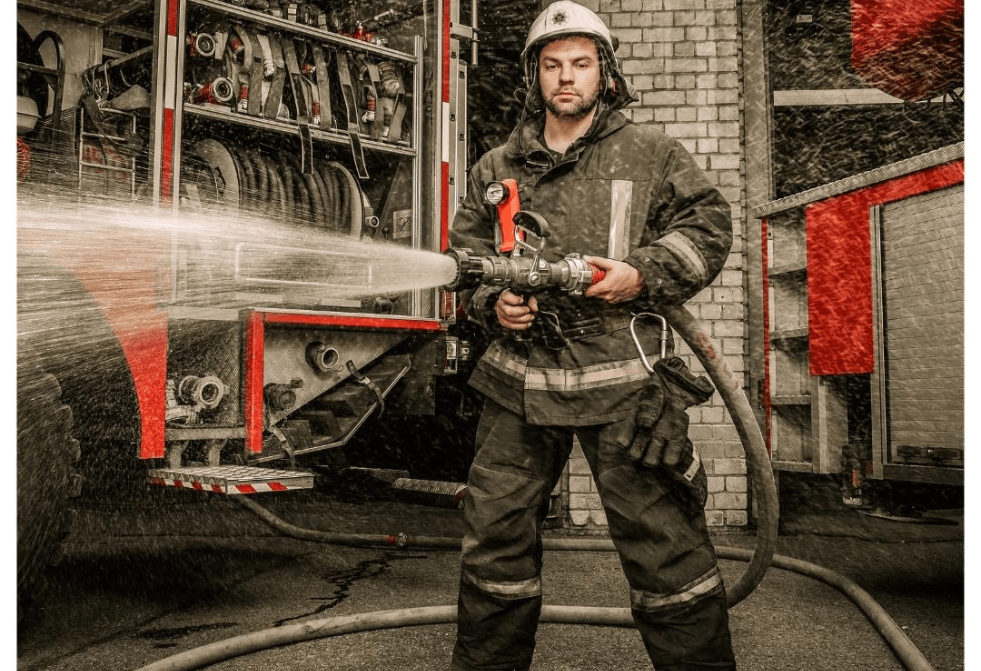
WHAT IS THE CLOTHING OF FIREFIGHTING?
Firefighter’s garments feature advanced materials and engineering precision, making them different from everyday clothing. Contrary to ordinary garments, firefighter clothing incorporates layers of advanced materials designed to offer unrivaled protection against the intense heat and hazards encountered in the line of duty.
What does firefighting clothing consist of?
- A firefighter’s helmet.
- A fire-fighting outfit consisting of a jacket and pants.
- Firefighters’ gloves.
- Protective shoes or boots.
How does firefighter clothing protect against heat and flames?
The outside fabric of firefighter clothing is designed to withstand flames and high temperatures. These advanced materials act as a barrier, preventing burns and injuries by resisting the intense heat encountered in firefighting scenarios. This level of protection is unmatched by ordinary garments.
What are the key components of firefighter clothing?
Firefighter clothing comprises three crucial layers – the outer shell, moisture barrier, and thermal barrier. The outer shell, often crafted from flame-resistant materials like Nomex or Kevlar, forms the first line of defense. The moisture barrier shields against water and hazardous liquids, while the thermal barrier insulates against extreme temperatures.
How does firefighter clothing protect against heat and flames?
The outer shell of firefighter clothing is designed to resist flames and high temperatures. These advanced materials act as a formidable barrier, preventing burns and injuries by withstanding the intense heat encountered in firefighting scenarios. This level of protection is unparalleled in comparison to regular clothing.
Are there specific standards that firefighter clothing must meet?
Firefighters’ clothing must comply with strict standards set by the European PPE Directive, as well as international standards. These standards cover flame resistance, thermal protection, durability, and other essential factors. Compliance ensures that the equipment offers reliable protection under the most demanding conditions, in accordance with the standards:
-EN 469:2005: performance requirements for fire protective clothing (fire, heat, mechanical and chemical properties, etc.) This standard demands high performance, which is verified in 20 tests. Essentially, the standard determines 4 key values: Xf (flame), Xr (radiance), Y (impermeability), and Z (breathability).
– EN 15614: performance requirements for wild land firefighting clothing. Standard EN 15614:2007 specifies the various performance requirements to be met by clothing worn when fighting natural fires. As forest fires occur mainly in summer, radiant heat can be very high for a very long period. Clothing complying with this standard prevents metabolic heat from becoming too high. Clothing suitable for these conditions must be lightweight, without causing thermal stress.
-EN ISO 15384:2020: New performance requirements for forest firefighting clothing. This new standard replaces EN 15614. It also sets out the various performance requirements that forest firefighting clothing must meet.
-ISO 11612 & ISO 14116: protective clothing against heat and flame. These standards specify performance requirements for fire, heat (radiant, convective, and contact), and large splashes of molten metal. This standard does not apply to structural fires.
What is the importance of the moisture barrier?
The moisture barrier is a waterproof layer that prevents water from reaching the firefighter’s skin. This is crucial as wet clothing can conduct heat more efficiently, increasing the risk of burns. Additionally, the moisture barrier also acts as a barrier against hazardous liquids and chemicals.
How do firefighters stay cool while wearing such protective gear?
Firefighter clothing is designed with ventilation features, including openings and mesh panels, to allow heat and moisture to escape. Some gear also incorporates breathable materials to enhance comfort during intense firefighting operations.
How important is proper sizing and fit in firefighter clothing?
Proper sizing and fit are critical for firefighter safety. Ill-fitting gear can hinder mobility and compromise protection. Firefighters often undergo precise measurements to ensure that their clothing provides optimal coverage without restricting movement.
What kind of clothing should firefighters not wear?
Wear synthetic underwear because synthetic materials wick moisture better than approved cotton or wool underwear. Laboratory tests have shown that firefighters wearing synthetic underwear are more susceptible to burns because synthetic materials can melt and stick to the skin.
Who wears fireproof clothing.?
FR workwear/clothing is recommended for anyone who works with or around combustibles. This most commonly includes industries such as Electricity production & and distribution. Metal smelting & and casting.
What is the fireproof fabric?
Flame-retardant fabrics are made from generally synthetic fibers that resist ignition in the event of prolonged exposure to flame or heat. For this reason, they are also sometimes referred to as inherently flame-retardant fabrics. These fabrics do not burn but eventually melt.
What fabric Cannot catch fire?
Most synthetic fabrics, such as nylon, acrylic, or polyester resist ignition. In the heart of every blaze, a hero stands armed not with a cape, but with a suit designed to defy the elements.
How has technology influenced the evolution of firefighter clothing?
Technology has been a driving force behind the evolution of firefighter clothing. Innovations such as moisture-wicking fabrics, integrated communication systems, and smart textiles have transformed these garments. This constant push for advancement ensures that firefighters are equipped with state-of-the-art gear that not only protects but also enhances their overall performance in the field.





